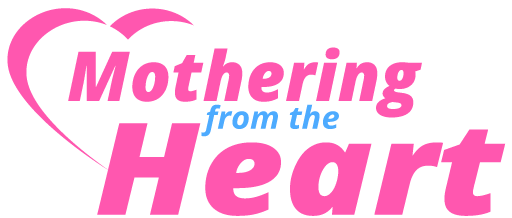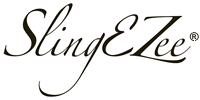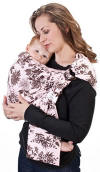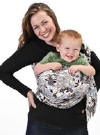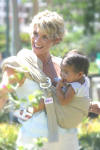SlingEzee and Hava Sling Instructions
Instructions for SlingEzee and HAVA Slings
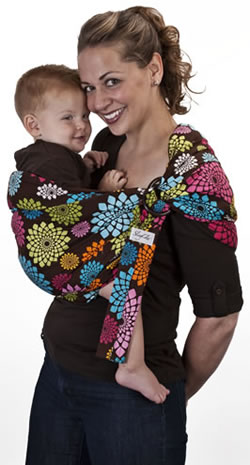
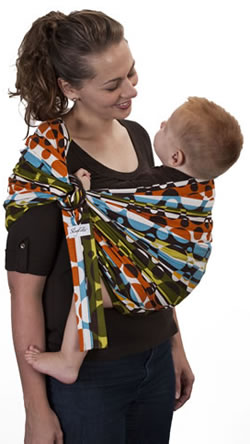
Instructions for Baby Wearing with your Sling Ezee and HAVA Baby Slings
Keep in mind that when a baby is worn in the SlingEzee or HAVA sling, they are held in a natural position just as if the Sling were not there. The material will be used to support the baby in the natural holding positions such as over the shoulder (snuggle hold), cradled in arms as when breastfeeding, or the hip carry for older babies. The DVD will be very helpful and these instructions online should be all you need, but if you still need assistance, send us an email or give us a call because your size may not be correct. If your size is correct, we may be able to fine-tune some things over the phone.
Parts of Your Sling
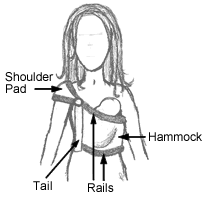
To be successful using your HAVA or SlingEZee, it helps to know the parts of the sling as they are referenced below. The stitched strap (SlingEZee) or flared zip pocket area (HAVA), from the label down, is referred to as the tail. The portion of the HAVA or SlingEZee that cradles your baby is the hammock. The rails are the top and bottom padded portions that line the hammock and continue on to provide comfort across your back and shoulder. The stitched pillow above the rings is the shoulder pad, designed for long-term comfort of wearing, especially as your baby grows into a toddler. The shoulder pad is not a pillow for your baby’s head. Lastly, the rings are called just that, the rings.
Buckling Your Sling
Hold the rings in one hand and the bottom of the tail in the other hand. For HAVA, the pocket side should be up. Pull all of the fabric of the tail through both rings until the label has come a few inches past the rings. Pull all of the fabric back through one ring, just like threading a belt. The label should end up just below the rings.
Key Tips for Comfort
Rest assured that, with practice, wearing your baby will become second nature to you. Most things that are truly worth it takes a bit of work, so hang in there until the art of babywearing comes naturally!
If you are right-handed, you may find that the position that feels best to you is to wear your HAVA or SlingEZee with the shoulder pad on your right shoulder. To do so, start with your hands out in front of you, with your sling draped on your left hand. The shoulder pad should rest on your left hand, with the tail hanging between your two hands. Next, slide the sling up your left arm and over your head, resting the shoulder pad on your right shoulder. If you’re left-handed, you will probably feel more comfortable with the shoulder pad on your left shoulder, so follow the above directions using the opposite sides. The hammock where your baby will be cradled goes across your chest like a banner. The rings should come just between your breast and shoulder. This is called the neutral position.
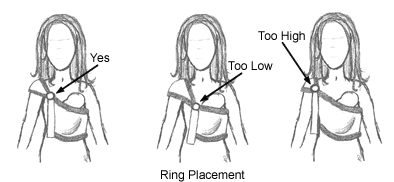
One of the three keys for comfort when wearing a sling is to make sure the rings always end up between your breast and shoulder, no matter which position you wear your baby in. The second key tip for comfort is the position of the shoulder pad. Make sure the shoulder pad is on your shoulder cap (so that it looks to be diagonal), rather than sitting on top of your shoulder or between your shoulder and neck. This is important, allowing the fabric of your HAVA or SlingEZee to drape properly across your back (which is actually the third key for comfort). When wearing an infant, you may find that you’re comfortable even with the shoulder pad on top, but as your baby grows, it will
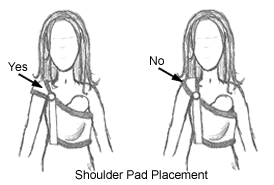
certainly make a difference to slide the shoulder pad to the cap of your shoulder. Draped properly, your baby’s weight will be distributed across your body for long-term comfort of wearing. If your rails are crisscrossed anywhere, then the fabric cannot be spread out properly for weight distribution. The best position for your rails to be in on your back is parallel to each other, and as far away from each other as possible.
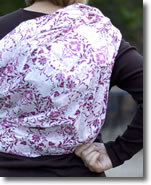
If you find yourself experiencing some discomfort, try this. Reach behind your back, below the shoulder pad area, and pull the sling fabric down some. Of course, this can’t be done if your shoulder pad is on top of your shoulder, rather than on your shoulder cap. Also, check to make sure the baby is at or above your waistline. I find that when I tug down on the fabric to make sure my baby’s weight is distributed properly, any discomfort goes away!
In review, the three keys for comfort are:
1.The rings should be between your shoulder and breast.
2.The shoulder pad should be on your shoulder cap, rather than on top of your shoulder.
3.The fabric of your sling should be spread out across your back as much as possible with rails not crisscrossing, and spread as far away from each other as possible.
Placing Baby in the Sling
With your HAVA or SlingEZee on in a neutral position, start with the rings a bit too high (almost touching your shoulder) so that they will end up in a corsage position after you adjust your sling. Initially, you will securely hold your baby high on your shoulder, outside of the sling, opposite the sling rings. Rather than lowering the baby into the sling and placing the baby’s weight on the sling, the lower baby between your chest and the sling fabric, but keep holding the baby with your arm. Before you place the baby’s weight in the sling, it is important to sweep any excess fabric from around your back, across the baby’s body, toward the rings. After pulling the excess fabric across the baby’s body, you’re ready to make the initial adjustment – pulling the tail (from the label down). Pull the tail until the sling fabric is wrapped securely around the baby, with the baby high on your chest, where you would naturally carry him or her with your arms. All the while, hold your baby securely with your arms until you have wrapped your baby in the safety of the sling and made all adjustments necessary. Detailed instructions regarding specific positions follow.
Bubbling (Adjusting the Top Rail Only)
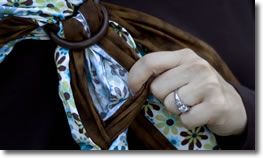
The bubbling technique is key to getting your baby snug against you so that you can be hands-free. Bubbling is what you do to take up excess material in just one rail. Most people find that after making the initial adjustment of pulling the entire tail (to adjust how high the baby is positioned against the chest), a second adjustment is needed – adjusting the top rail only. To do so, reach just below the rings, between the rings and the HAVA or SlingEZee label, and find the piece of material that relates only to the top rail. The material splits just above the label, making it easy to see the fabric that corresponds to each rail. Pull on the fabric split that matches the loose rail, and pull that piece of fabric just below the rings until you have made it look like a bubble. This tightens the top rail, pulling your baby closer to you which will make a huge difference in comfort for you. Many find that they use the bubbling technique more as their infant is worn in an upright carry position. Also, as your toddler is worn in a hip straddle, you may find that they will recline away from you if there is any slack. You don’t want your baby hanging low or away from your body. The closer your baby is to your body, the safer baby is and the more comfortable you will be.![]()
Postioning your Baby in the SlingEzee and Hava Baby Slings
Before you try wearing your baby in your HAVA or SlingEZee, keep in mind that babies are great at picking up on anxiety. So, as you’re about to try babywearing, just relax and rest assured that it gets easier and easier as you practice! When beginning to use your sling, it helps to start with a well-rested, just fed baby. Also, it helps to slowly walk around once you slip your baby into the sling since babies love motion.
Cradle Hold
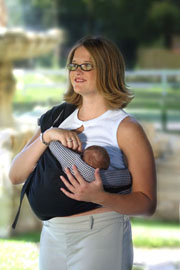
The cradle hold is generally used for an infant, a sleeping baby, or for breastfeeding a baby at any age. Your baby can be cradled with their head on the ringside, or opposite the rings. Most find that they prefer to cradle their baby with the head opposite the rings after the first month or two, or while breastfeeding (this provides more room for you to latch the baby on). Cradling a baby with their head near the rings means that the baby’s entire body – legs and all – remain in the sling. Baby will outgrow this position quickly! Placing baby with their head opposite the rings allows baby’s feet to hang out. As baby grows, the sling will securely wrap around their bottom, and their legs may hang out, knees to feet. This position allows even a breastfeeding toddler to be accommodated safely in the HAVA or SlingEZee.
WARNING: Positional asphyxia (suffocation) can occur in young babies. Although this has never happened in one of our slings we want to alert you that this can happen when a baby’s chin is pressed against his or her chest, restricting airflow. Always check to ensure that baby’s airway is unobstructed and baby is breathing regularly at all times, especially when sleeping.
Begin with your HAVA or SlingEZee in the neutral position, with the rings a bit higher than the corsage position. Pull all excess fabric from around your back, then create a hammock for your baby by placing the lower rail of your sling against your chest. Let’s assume that you’re placing the baby’s head opposite the rings. If the shoulder pad is on your right shoulder, then hold your infant in your right arm. With your left hand, hold the hammock of your HAVA or SlingEZee open and bring your baby up and over the top of the hammock, placing their feet toward your right hip. You may desire to rest your infant’s head inside of the top rail or on the top rail. With baby’s body in the hammock and with the lower rail securely between you and your baby, slowly remove your right arm from under your baby and release them into the sling while supporting them with your left arm outside of the sling.
To bring your baby closer or higher, use your left arm to lift your baby. Pull down on the tail with your right hand to tighten the material and bind your baby next to your body. Make sure you continue to have an amount of hammock fabric between your body and your baby, for a secure hold, before letting go with your left hand.
If you have placed your baby’s head on the ring side of your HAVA or SlingEZee, then notice that if the rings are in the proper position, they should not touch your baby’s head. If they do, the rings are probably too low or your baby is too big and would be better accommodated with their head opposite the rings. Also, notice that your baby’s feet rest inside of the sling and that the position of the sling fabric places your baby in a natural reclining position.
Snuggle Hold
The snuggle hold is often a favorite position for infants whenever they are not breastfeeding. The snuggle hold is also great for a baby that needs to be burped. Begin with your HAVA or SlingEZee in the neutral position, with the rings a bit higher than corsage position. With both hands, hold your baby high on your exposed shoulder, opposite the rings. Open the hammock some and slide your baby into your HAVA or SlingEZee vertically, facing you. Their head should rest near your heart. While supporting your baby against your body, pull the top rail of the SlingEZee around them and place it behind their neck. Before placing your baby’s weight on the sling, direct all excess fabric around the baby’s body, toward the rings. While continuing to support your baby’s weight with your arms high on your chest, pull the tail (at the label or below) until your baby is riding at your waist or higher. Now adjust the top rail alone by “bubbling” the top rail. This ensures that your HAVA or SlingEZee is snug enough, so your baby’s head will be held securely with the top rail supporting it. Make sure to keep some material between you and your baby by pulling the lower rail under your baby. Notice that an infant – feet and all – will be cradled entirely inside the hammock in this carry. As your baby grows, you may want to bring their feet outside of the lower rail for the baby’s and your comfort. To do this safely, place the baby in a “froggy” position. This means that their knees are higher than their bottom, and the sling fabric is wrapped securely around their bottom, with the lower rail under their knees. This ensures that there is hammock fabric securely between you and your baby.
Kangaroo Carry
Your HAVA or SlingEZee is great for the versatility of wearing positions it offers. Many find that their babies want to see their world, and the kangaroo carry is perfect for that. The kangaroo carry is also helpful for allowing fussy babies to pass gas, as it brings their knees up into their tummies where they are feeling pain.
Beginning with your HAVA or SlingEZee in the neutral position, with the rings a bit higher than the corsage position, take the bottom railing and pull it around the front of your body just below your breast. Use your right elbow to hold it in position. Then take the top railing and pull it toward the front to make a hammock. Hold your baby against you, with their back against your chest. Support them in a chair-like position and cross their legs. With your free hand, hold the hammock open while you lower your baby’s bottom into the hammock. Take the lower rail and pull all excess fabric from around your back toward the rings, and make certain the material is between your body and your baby’s back. Your baby will sit in the hammock with their legs crossed, tailor style. You’ll continue to support your baby in your HAVA or SlingEZee so they are riding at your waist or higher, pulling on the tail (label or below) to tighten. Next, tighten the top rail alone as needed, by “bubbling” the top rail.
Hip Straddle
Your HAVA or SlingEZee is wonderful for wearing babies well into toddlerhood. The hip straddle is a great position for toddlers, as well as babies who are about 6 months old and up. They benefit from seeing the world around them while remaining in their secure place.
Begin with your HAVA or SlingEZee in the neutral position, with the rings a bit higher than the corsage position. Pick up your baby or toddler and place their tummy high on your exposed shoulder, opposite the rings. Reach between the sling fabric and your body to grab your child�s feet. Bring both feet through your HAVA or SlingEZee and place your child on your hip. Pull any excess fabric around your child’s body, toward the rings. While supporting your child at your waist or higher, pull the tail (label or below) to tighten. The top rail will go behind your child’s shoulders or can be pulled up to support their head if they fall asleep. Ensure that your child is in a “froggy” position. This means that their knees are higher than their bottom, and the sling fabric is wrapped securely around their bottom, with the lower rail under their knees. In this way, hammock fabric is securely between you and your baby. Keep in mind that toddlers will recline away from you if the fabric is too loose behind their back. It is important, for your comfort, to tighten the top rail alone as needed, by “bubbling” the top rail.
You’ll find that toddlers who are used to the sling will automatically tuck their legs up and stick them through the sling. If your toddler is not familiar with the sling, you may have to reach in and take hold of both feet, pulling them through onto your hip. When your toddler is ready to get down and play, the simple way to let them go is to loosen the sling as you squat, allowing your toddler to slide out of the bottom of your HAVA or SlingEZee.
